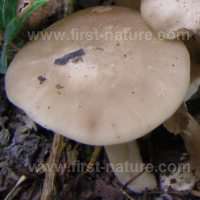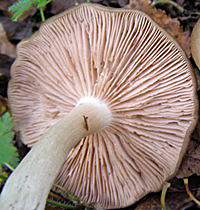Entoloma rhodopolium (Fr.) P. Kumm. - Wood Pinkgill
Phylum: Basidiomycota - Class: Agaricomycetes - Order: Agaricales - Family: Entolomataceae
Distribution - Taxonomic History - Etymology - Identification - Culinary Notes - Reference Sources
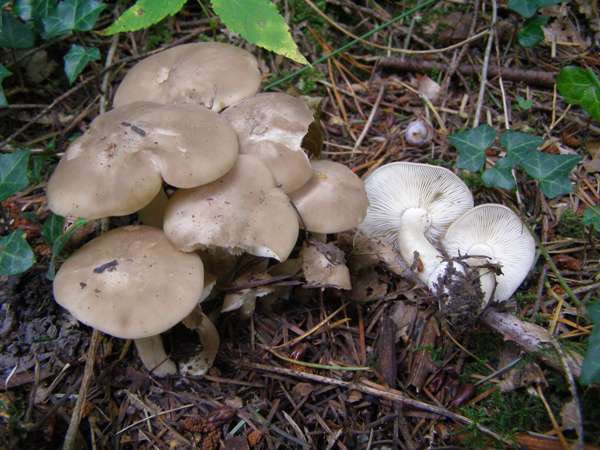
This very common pale pinkgill occurs in deciduous broadleaf woodland, usually in quite large groups.
A form of this poisonous mushroom gives off a nitrous smell, and it was formerly - Classed as a separate species Entoloma nidorosum. Several toxins have been isolated from Wood Pinkgills, including muscarine. Not surprisingly, eating this species has been known to cause some very unpleasant stomach upsets.
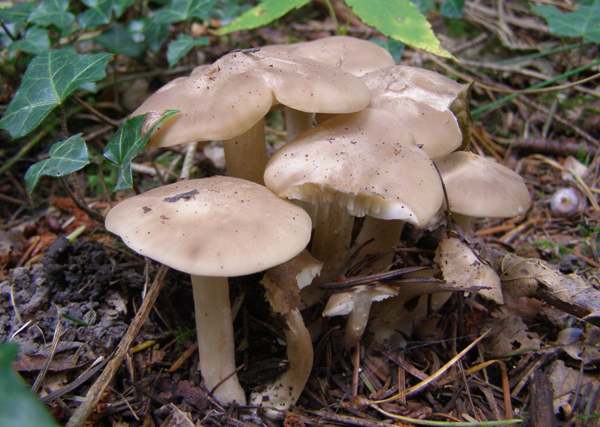
Distribution
The Wood Pinkgill is a very common find in Britain and Ireland, where it is widely distributed in broadleaf woodlands and on woodland edges. This gregarious pinkgill occurs also throughout mainland Europe and Asia as well as in North America. There is some question as to whether the North American form of this mushroom is a different species from the Wood Pinkgill that occurs in Europe and Asia.
Taxonomic history
When in 1818 the great Swedish mycologist Elias Magnus Fries described this pinkgill mushroom species he gave it the binomial name Agaricus rhodopolius. (Most gilled mushrooms were, in those early days of fungal taxonomy, initially placed in a gigantic Agaricus genus the majority of whose occupants have since been redistributed across many new genera.)
It was the German mycologist Paul Kummer who, in 1871, transferred this species to the genus Entoloma, at which point its scientific name became Entoloma rhodopolium.
Synonyms of Entoloma rhodopolium include Agaricus rhodopolius Fr., Agaricus nidorosus Fr., Entoloma rhodopolium f. rhodopolium (Fr.) P. Kumm., Entoloma nidorosum (Fr.) Quél., Rhodophyllus rhodopolius (Fr.) Quel., Entoloma rhodopolium f. nidorosum (Fr.) Noordel., and Entoloma rhodopolium var. nidorosum (Fr.) Krieglst.
Etymology
The generic name Entoloma comes from ancient Greek words entos, meaning inner, and lóma, meaning a fringe or a hem. It is a reference to the inrolled margins of many of the mushrooms in this genus.
The specific epithet rhodopolium comes from the prefix rhodo- meaning reddish (in this case rather pinkish), and -polius meaning grey. (Grateful thanks to Robert M Hallock for help with the etymology of this species.)
Identification guide
Cap3 to 5 cm across, convex, flattening and often becoming broadly umbonate, occasionally with a shallow depression, the cap of Entoloma rhodopolium has a faintly striate margin when dry, and the rim is slightly incurved and wavy; cap colour is beige, turning paler when dry. |
|
GillsAdnate; white, turning pink as the spores mature. Stem4 to 9 cm long and 3 to 6mm diameter; smooth; white or pale beige, silky; no stem ring. |
|
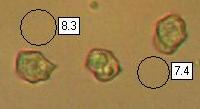 |
SporesSubglobose, angular, 8-10.5 x 7-8μm. Spore printPink. |
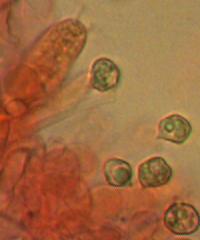 |
The spores and basidium pictured on the left are from Entoloma rhodopolium var. pseudopolitum. |
Odour/taste |
Not distinctive. |
Habitat & Ecological role |
Saprobic, usually in moderate to large groups in broadleaf deciduous woodland. |
Season |
Fruiting from summer to late autumn in Britain and Ireland. |
Similar species |
Entoloma rhodopolium is very distinctive when fully developed, but before the gills turn pink it could perhaps be mistaken for a Buttercap, Rhodocollybia butyracea. |
Culinary Notes
Reported to be poisonous and the cause of gastric upsets if eaten, Entoloma rhodopolium is definitely not one for the pot. (Some Entoloma species - for example Entoloma sinuatum - are deadly poisonous and are known to have caused several deaths.).
Reference Sources
Fascinated by Fungi, 2nd Edition, Pat O'Reilly 2016, reprinted by Coch-y-bonddu Books in 2022.
Worthington George Smith (1908) Synopsis of the British Basidiomycetes, p. 107.
Knudsen H., Vesterholt J. (eds) Funga Nordica: agaricoid, boletoid and cyphelloid genera - Nordsvamp, 2008
Dictionary of the Fungi; Paul M. Kirk, Paul F. Cannon, David W. Minter and J. A. Stalpers; CABI, 2008
Taxonomic history and synonym information on these pages is drawn from many sources but in particular from the British Mycological Society's GB Checklist of Fungi.
Fascinated by Fungi. Back by popular demand, Pat O'Reilly's best-selling 450-page hardback book is available now. The latest second edition was republished with a sparkling new cover design in September 2022 by Coch-y-Bonddu Books. Full details and copies are available from the publisher's online bookshop...
